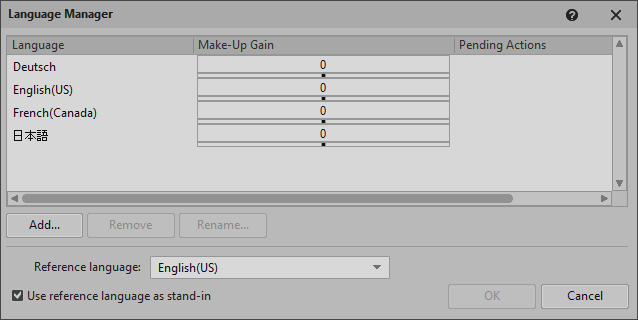版本
With the “Language Manager”一节, you can define the languages used for “Localizing your project”一节 and set a Make-Up Gain (volume offset) for each. You can also set the stand-in reference language.
All languages defined in a project are listed in the Language Selector in the toolbar and in the Contents Editor for Sound Voice objects. See “Switching to a different project language”一节 and “Contents Editor: Voice(音频源的内容编辑器)”一节.
To open the Language Manager, from the Wwise menu bar, click Project > Language Manager (Shift+J).

![[注意]](/images/2023.1.3_8471/?source=Help&id=caution.png) | 注意 |
|---|---|
These actions cannot be undone. We recommend you back up your project before proceeding. |
点击 Add。
In the Add Language dialog, enter a language name using any OS-supported characters.

单击 OK(确定)。
The Pending Actions column is updated. To remove or rename the new language, select it and click the respective button. To cancel the action, click Cancel.
Click OK to execute any pending actions. A message appears warning you that the changes cannot be undone.
Click Yes to proceed.
The Process Log might open with messages for the executed actions.
Select a language and click Remove.
The Pending Actions column is updated. To cancel the change, click Cancel.
Click OK to execute any pending actions. A message appears warning you that the changes cannot be undone.
Click Yes to proceed. Depending on your project setup, a message might appear warning that corresponding audio files and plug-ins will be deleted.
Click Yes to proceed.
The Process Log might open with messages for the executed actions.
Select a language and click Rename.
In the Rename Language dialog, enter the new language name using any OS-supported characters.

单击 OK(确定)。
The Pending Actions column is updated. To cancel the change, click Cancel.
Click OK to execute any pending actions. A message appears warning you that the changes cannot be undone.
Click Yes to proceed.
The Process Log might open with messages for the executed actions.
Because some language files might not be available when you add a language, you can set a reference language as a substitute for languages that are not yet ready. The conversion settings associated with the reference language can also be used as default conversion settings for other imported language files.
从 Reference language 列表中选择一种语言。
Use reference language as stand-in is enabled by default. 这样的话对于本地化音频文件尚未到位的语言会将参考语言的音频文件暂时纳入 SoundBank(音频包)中。
Click OK to execute any pending actions. A message appears warning you that the changes cannot be undone.
Click Yes to proceed.
The Process Log opens with messages for the executed actions.
If your localized assets contain dialogue from different studios with different actors and recording conditions, you can balance them and match the levels for each language.
The Make-Up Gain is the volume gain in decibels applied to the voice after all other volume adjustments. 补偿增益在 Actor-Mixer Hierarchy(角色混音器层级结构)中具有叠加特性。See Understanding the voice pipeline and Using Loudness Normalization or Make-up gain to Adjust Volume.
选择语言。
In the Make-up Gain column, use the slider to set a value from -24 to 24, or type it in.
Click OK to save the setting. If the volume offset of some files differs from that of their language, a message box appears offering to conserve or overwrite the file offset.
Click Conserve or Overwrite to continue.